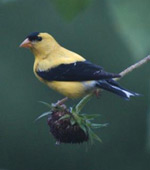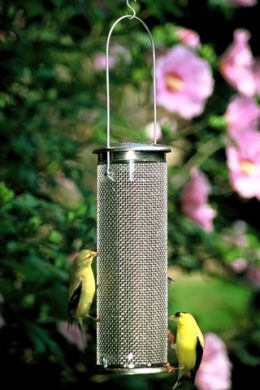Common Birds
American Goldfinch

One of the most popular birds attracted to backyard bird feeders is the American Goldfinch. These small finches are commonly referred to as wild canaries with the male a vibrant yellow in the summer. In basic plumage during the winter months he molts into an olive drab. The female on the hand is a dull yellow-brown shade which brightens only slightly during the summer. The male displays brightly colored plumage during the breeding season to attract a mate. But even in their basic plumage the white wing bars remain an identifiable feature along with the notched tail, conical beak, and lack of streaking. Although the beak is dull most of the year it becomes bright orange with the spring molt. The American Goldfinch measures 4.5 to 5 inches in length with a wingspan of 7.5 to 8.5 inches weighing in at less than an ounce. These handsome little finches are the state bird of New Jersey, Iowa and Washington.
Goldfinch can be found year round from the Carolinas northward across the central and northern U.S. They occur across Southern Canada during the summer breeding season then move south. Considered a short distance migrant, many of our summer residents Goldfinches drift south toward the Gulf Coast and southwestern United States into Mexico during the winter months. They are replaced by the northern population which moves south from Canada during the winter months. By March our resident Goldfinch return joining the northern population which will remain here into early May before returning north following the dandelion blooms.
The American Goldfinch prefers open country where weeds thrive, such as fields, meadows, flood plains, along roadsides, in orchards, and gardens. They are also found along the edges of open deciduous and riparian woodlands and areas of secondary growth. These areas are particularly prime habitat when overgrown with sunflowers, asters, and thistle plants providing a good food source with scattered shrubs and small trees for nesting. This habitat preference continues during the spring and autumn migrations.
The conical shape and size of the Goldfinches beak aids in the extraction of seeds from the seed heads of thistles, sunflowers, and other composite plants while clinging with their feet. They will also feed on the seed heads of grasses and dandelions along with the seeds of alder, birch, and cedar trees. Goldfinches are common in suburbs, parks, and urban areas. At backyard bird feeders they prefer Nyjer thistle, black oil sunflower seed and hulled sunflowers. I have a seed tube feeder filled with Nutra-Saf safflower seed which seems to attract them as well.
Unlike some finch species, the American Goldfinch uses its feet extensively in feeding. It frequently hangs from seed-heads while feeding in order to reach the seeds more easily. In the spring, the American Goldfinch feeds on the catkins hanging from birches and alders by pulling one up with its beak and using its toes to hold the catkin still against the branch. This dexterity enables it to take advantage of food sources relatively inaccessible to potential competitors, increasing its chances of survival.
Between March and early May when our resident Goldfinches return joining the northern Goldfinches that are waiting to move back north has been dubbed finch season by those who maintain thistle feeders. They can become quite abundant around feeding stations. But by the second week in May the northern population has moved back to their summer range. We are left with our resident Goldfinches that will continue to patronize bird feeders in urbanized areas until late June. By then they will begin to drift into outlying areas across the countryside to begin nesting. During the past several summers in our neighborhood I usually see a few Goldfinches visiting the feeders, probably unmated birds. Folks in rural areas will continue to see a lot of activity at their finch feeders until mid to late August. At that time it appears the Goldfinches prefer the bounty of natural foods that have become available.
The American Goldfinch is very social during the non-breeding season and is often found in large flocks. These flocks may include Pine Siskin, Common Red-polls and other finches. Flocks generally fly in an undulating pattern, creating a wave-shaped path. During the breeding season they live in loose colonies. While the nest is being constructed, the male will act aggressively toward other males who intrude into his territory, driving them away, and the female reacts in the same way toward other females. This aggressiveness fades once the eggs have been laid.
The American Goldfinch is a late nester. Their primary diet is seeds and seeds are fed exclusively to their young in the nest. The nestlings of most other birds begin their lives being fed high-protein insects. Waiting to begin nesting in July assures the Goldfinches there is a large enough supply of natural seeds to support raising a family.
The male and female Goldfinch are monogamous and will select a nesting site together usually in a shrub or small tree in an open area. Plum thickets are ideal. The nest is constructed by the female where two or three small vertical branches join. The male will join her when collecting materials and even help bring items back for her to use. The nest is often shaded from above by leaves but visible from underneath. The nest cup, which is about 3 inches across and 3 to 4 inches deep, is made from rootlets and other plant fibers then lined with plant down from the same plants they feed on. The nest is anchored to the branches by spider silk. Once completed the nest is so tightly woven together that it can hold water. During rainstorms an adult must be on the nest to prevent the eggs from floating out or the young drowning once they have hatched.
It takes about six days for the female to build the nest after which she will lay 2 to 7 pale bluish white eggs, often with light brown spots on the larger end. When the clutch is completed incubation begins taking approximately 12 to 14 days before they hatch. The young will remain in the nest for another 11 to 17 days. Once they are ready to leave the nest they begin to practice short flights close by. For up to three weeks after fledging they will continue to be fed by the adult male who locates them by listening for their fledging call. The chicks will stop giving this call when they become entirely independent foraging for their own food. In northern regions there will be one brood each season, with two broods possible in southern warmer areas.
The song of the American Goldfinch is a series of musical warbles and twitters, often with a long note. A tsee-tsi-tsi-tsit call is often given in flight; it may also be described as po-ta-to-chip. While the female incubates the eggs, she calls to her returning mate with a soft continuous teeteeteeteete sound. The young begin to use a call of chick-kee or chick-wee shortly before fledging, which they use until they have left the nest entirely. The American Goldfinch does not act aggressively toward predators within its territory; its only reaction is alarm calling. Predators include snakes, weasels, squirrels, and Blue Jays, which may destroy eggs or kill young, and hawks and cats, which pose a threat to both young and adults. There are two defense calls made by adults during nesting; a sweeet call made to rally other goldfinches to the nest and distract predators, and a bearbee used to signal to the nestlings to quiet them and get them to crouch down in the nest to become less conspicuous.
The American Goldfinch is widespread throughout its range and has not been overly threatened by human activity. The clearing of forests by humans, though harmful to many bird and wildlife species, has benefited the American Goldfinch. Clearing wooded areas creates open spaces which are the preferred environment of these little finches. Spaces where weeds thrive producing the primary food source of the American Goldfinch.
Goldfinches are easily attracted to backyard bird feeders but many natural plants can attract them as well. Planting grasses, composite plants like sunflowers and perennial plants such as zinnias, cosmos, bee balm, coneflowers, or globe thistle produce seed-heads favored by finches. Leave these plants in your flower beds during winter after they have gone to seed and you may be surprised at what other birds show up for dinner.
Wingtip: Cowbirds parasitize on a variety of birds by laying their eggs in other bird’s nests. The Cowbird nestlings grow rapidly receiving up to 100% of the food the host bird brings to the nest while the other nestlings generally die from lack of nutrition. When Cowbirds lay their eggs in the nest of a Goldfinch they perish since the diet offered to the Goldfinch nestlings is strictly seed. Cowbirds developed this method of laying their eggs in other bird’s nests leaving the host bird to raise their young since they followed the ever moving bison herds leaving little time to stop and raise a family.
